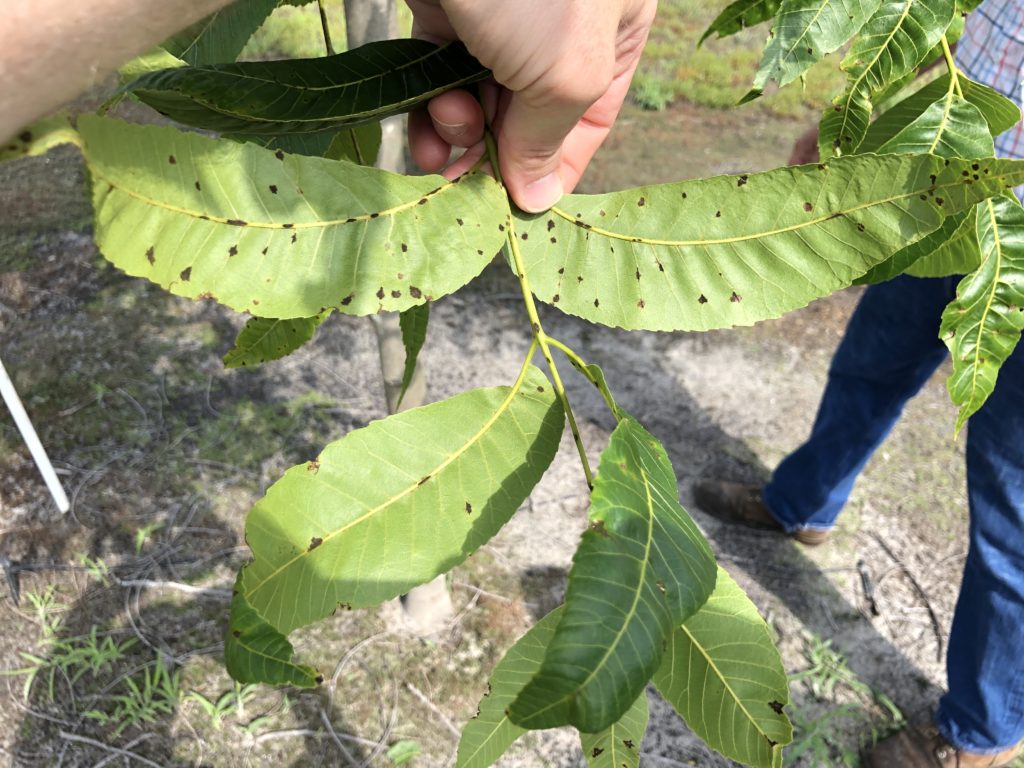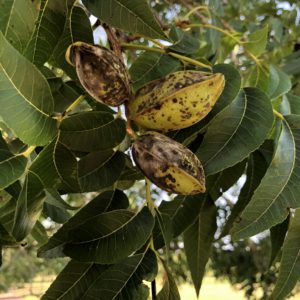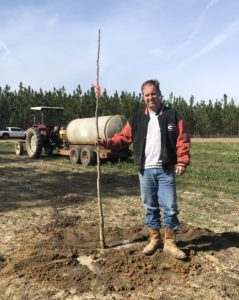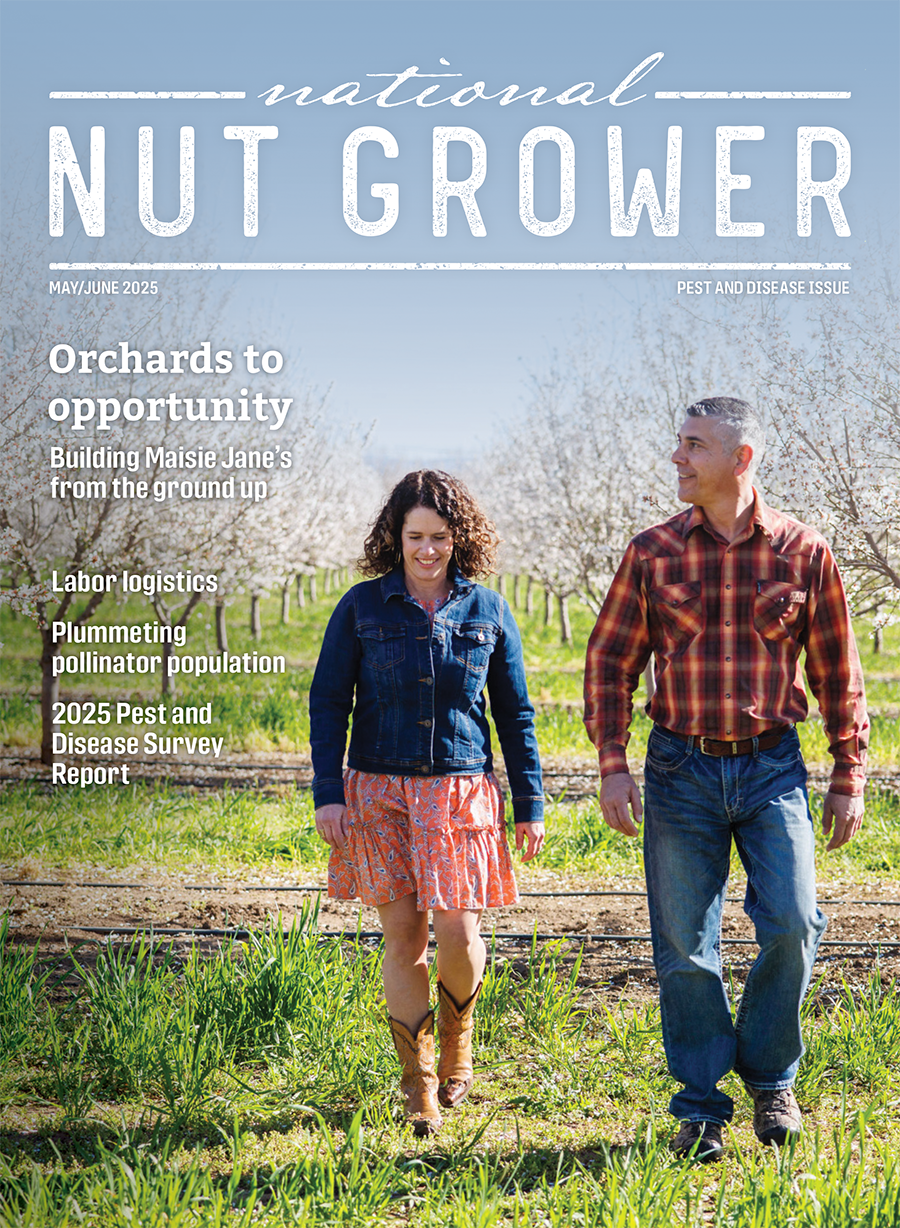
Summer 2021
Beating Georgia’s pecan scab
Pecan scab is a costly and persistent pest for Georgia pecan growers, and the Extension crew at University of Georgia (UGA) is making a valiant effort to battle it with new varieties.
The state’s stronghold variety is still Stuart with an estimated 40% of acreage planted to this variety, with Desirable – the export market’s ultimate darling – planted to about 25-30% of Georgia pecan acreage. And while these varieties have dominated the market for many years, they come with a strong caveat.
They are the most popular, but they are also the most highly susceptible to pecan scab.
With a large kernel, great flavor and color, and a thin, easily cracked shell, Desirable was aptly named and was the variety that set the pecan standard. An added bonus is its ability to shed its nuts and produce a crop every year, when most other pecan varieties are alternate bearing. It has a history dating back to the very early 1900s, and even though the variety was introduced in 1915 and was almost lost, it didn’t become commercially available until the mid-1940s, made a huge impact in the market in the 1960s, and absolutely dominated in the 1990s.
And now … Well, now growers are discouraged from planting Desirable at all.
Low, medium and high input
There is an average number of fungicide sprays for pecan scab, but what that number looks like is determined by the variety and location. Highly susceptible varieties, such as Desirable and Stuart (which is older than Desirable and also a variety Georgia is trying to move away from), can require up to 15 sprays in a season, especially if those farms are in Deep South Georgia, where the lower elevations have higher humidity and higher likelihoods for disease.
“Anywhere below highway 280 will really have an increased pressure of scab,” said Andrew Sawyer, UGA area pecan agent for Southeast Georgia. “But, for any varieties that get scab either a little or a lot, growers will be spraying from June 1 to August 15, spraying every other week and not missing a day.”
For highly susceptible varieties, the spraying starts earlier in the year with a single spray in April or May, starting budbreak and the pre-pollination and pollination phases to combat leaf scab. Because in June, during nut set, that same pathogen moves from the leaves to the schucks and nuts, causing nut scab, which is far more damaging to the yield than leaf scab.

This is also the time that growers move from their pre-pollination sprays to their pollination sprays.
“For varieties that get scab really bad, like Desirable, growers will see it on the leaves in the spring. But for a variety that doesn’t, you won’t see it on the leaves in the spring,” said Sawyer.
With the top varieties being so dependent on fungicide sprays to have a viable crop, it’s important to draw attention to the varieties that require less.
Medium input varieties are a little more user friendly when it comes to scab – they still become infected, but not as badly and don’t require that early season spray. The low input varieties, however, have yet to show any scab. For these, as a preventative measure, Sawyer and UGA Extension pecan specialist Lenny Wells recommend spraying those about three times a year at relatively random times.
Since 25% scab on nuts will result in economic losses to a grower, growers heed this warning with fungicide programs that cost about 12% of their variable cost budgets per year.
“If growers didn’t spray at all, they’d lose nearly all of the crop on these really highly susceptible varieties,” said Sawyer. “You’re basically looking at a total loss.”
As with most any crop, there are always those “what ifs” that rely on factors out of a grower’s control, such as the weather. And with the odds stacked against an unsprayed crop, growers aren’t likely to go without, which makes calculating the true loss a more difficult task. What are high input variety pecan growers to do with the “if you don’t spray, you’re done for” ultimatum hanging over their crops?
A balancing act
“What we’re really trying to do is teach growers how to manage fungicides,” said Sawyer.
So far, it has been a pretty decent year for scab. Normally for the state, it’s warm in March, but a series of low temperatures and a longer winter didn’t bring the heat and humidity until May. In fact, April nights were so cold this year that scab wasn’t able to progress on the trees.
While this is good for slowing scab, the cool temperatures also slowed the development of the leaves and flowers themselves. It has, however, enabled growers of highly susceptible varieties to increase their fungicide spray window. Instead of spraying every other week, growers have been able to push their sprays to three or four weeks. But the weather changes have also put the crop behind by 10 days, meaning that this could result in more sprays toward the end of the season in August in order to combat the more critical nut scab.
The goal is to beat the pathogen to the nut. Once a tree enters into the nut sizing period, any scab that makes it to the shuck will shut down kernel development. Once the shell inside the shuck hardens around mid-August, scab can’t really penetrate the shell to cause more problems.
Perks of low input
Climate swings – such as this year with atypical heat and chill temperatures – magnify the importance of fungicide spray management, because that management not only affects the crop, but directly affects the grower’s pocket.
“Where our prices are right now, and knowing we’re going to have a lower crop, we’ve already told our growers this isn’t a year for them to be doing 16 scab sprays,” said Sawyer. “They need to figure out how to do between 6-10. Ten on the high input, six on the medium input. If growers can’t figure that out, they’re just going to be losing.”

This is where the low input varieties have a tendency to shine. They don’t have scab issues, and while they do get a lower price than Desirable, removing the scab sprays from the budget means those low input varieties are actually yielding a better net income.
“It cuts out a lot of the spraying,” Sawyer said. “And in the state of Georgia, if you’ve got a variety that gets any scab, you’re going to have to pretty much stay on top of it from June to August, bottom line.”
Sawyer and UGA Extension have some low input varieties, such as Excel, Lakota and McMillan, that are yielding well, have a good percentage of meat and don’t have any scab. These have been in trial since 2008 in Tifton – a place with high scab pressure. There has been no scab observed on them so far.
“They’ve been down there for over 10 years, and their annual yield is sometimes more than Desirable,” Sawyer said.
These varieties are commercially available, and many nurseries in Georgia carry them. Kanza – a variety similar to Elliot – is another low input variety that will be made available in the state next year.
This is a good sign for growers and the industry’s leading pecan-producing state. Stories still linger of the days when pecan prices soared when China captured the market.
“It didn’t matter how many times you sprayed. If you made a good nut, you were going to get paid, hands down,” said Sawyer.
It also explains some growers’ curiosity when advised against Desirable. With trials showing promising results, it affirms why low input varieties are going into the ground to replace high input varieties, and why pecan acreage is increasing, particularly for hay fields, cut over pine and row crops. While the pine tree market (and beef cattle, for that matter) in Georgia has seen a decline due to competition, those with the land see the potential for pecans to generate higher income on that land. For those with smaller parcels, the spray demands for high input varieties just don’t make financial sense.
“Many people who plant pecans have another job. They’re borderline hobby farmers,” Sawyer said. “But what we’re seeing is land that’s shifting over to pecans more and more.”
Wells posts fungicide spray schedules every year on the University of Georgia Pecan Extension blog.
Above photo: Leaf scab on a 5-year-old Desirable.









